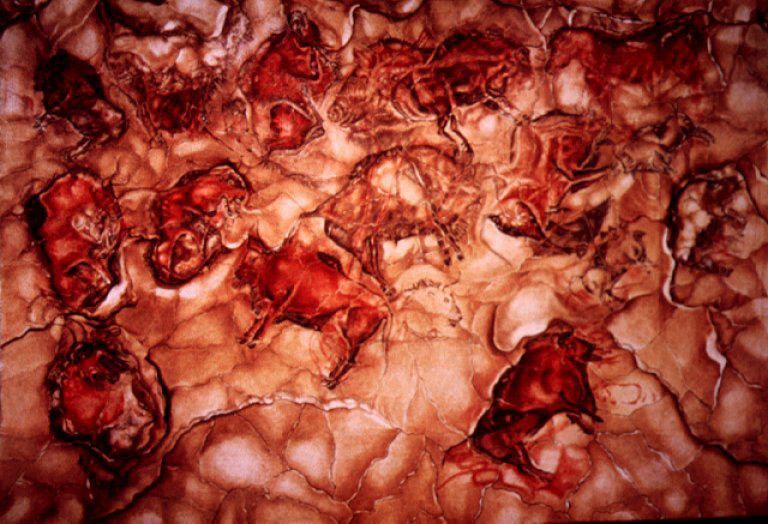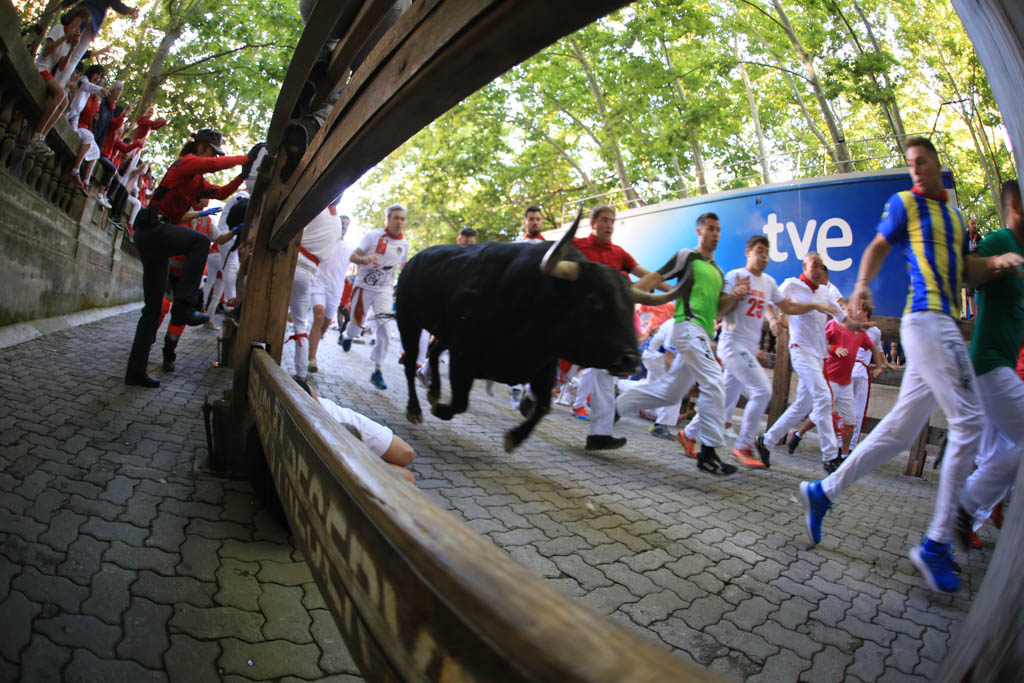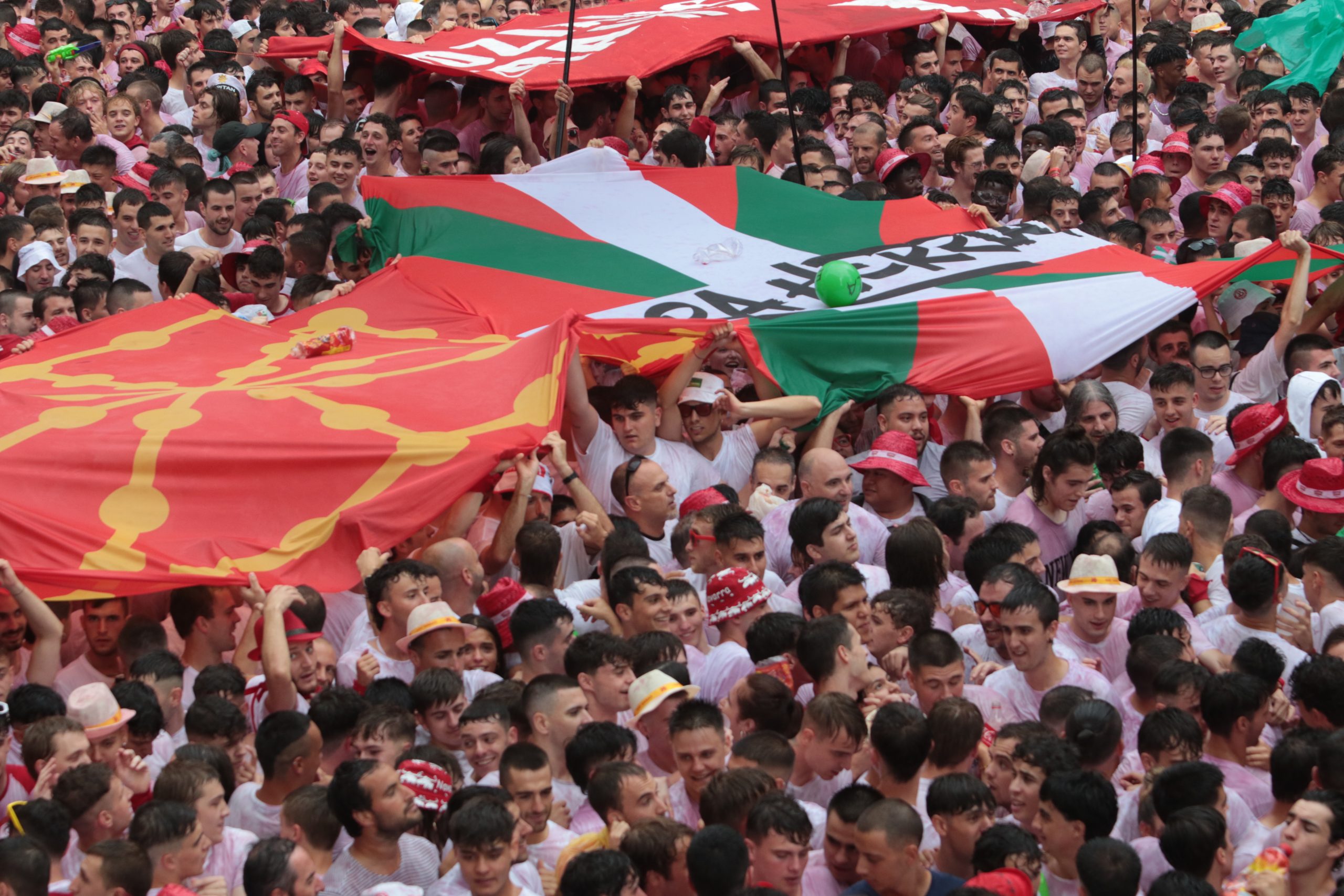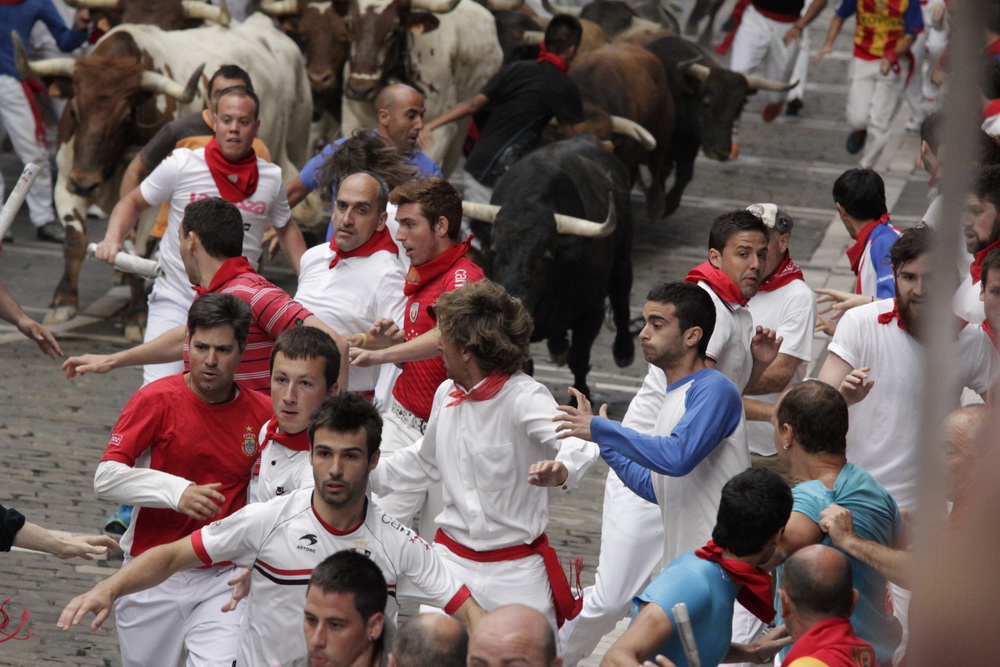As the last step of the Escalera is taken this June 6th before we’re submerged in the tsunami that is San Fermin, and that tidal wave of craziness and happiness and hangovers that is Pamplona in fiesta sweeps over us, this months bag of bull droppings has as it’s main part the chat I had with Julen Madina, and whether you know who he is or not, I hope you find it interesting. I certainly did. And of course there is other stuff too, starting with…this.
PRIMEVAL
That smell of bull…not the way they smell when you’re near them when you’re watching them in the corrals, or if you’re lucky or good enough to smell them as you run near them, or when they sweep by you in that fluid and majestical way they have sometimes, but I mean the smell they have when you are with them, right by their side or just in front of them as their horns rise and dip in that hypnotic fashion.
That smell…the one that envelopes you when you’re in the middle of the herd and your heart is pumping and you’re so close that they are touching you, and despite the noise of the hooves and the bells on the steers and the screams of the crowd…everything has gone quiet and time, in that strange way it has when something magical is happening to you in the run…time seems to be, if not actually stopped, then operating in it’s own little vacuum, speeding up and slowing down as your own particular run in your own personal world unfolds…
That smell you feel cloaking around you as you become a part of them and their own rhythm and you realise you are running like they are…you’ve joined the herd…but the tunnel into the ring is looming and you know that not only is there is no escape, but it dawns on you that there is no room for you and the bulls…and you know that it is you who is about to go flying as you hit the edge of the tunnel wall and you go down and under the hooves and yes, again, the bulls seem to make time hic-up in that magical, mystical way they have and you have become a part of them as you are rolled and then turned over right under them, every which way like one of those crazy fun fair rides, until you come out from underneath them and somehow you’re on your feet again and running out of the tunnel and into the sunlight and you hear the roar of the crowd and time has gone back to normal once more…but that smell, that primeval smell, is still with you and will be for hours…
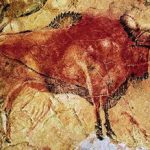
That smell…how do you describe it? These animals were painted on the walls of the Caves of Altamira, not a hundred and fifty miles from Pamplona, so there is not just something ancient about them, or wild and savage…but primitive. Yes, primeval. Those bulls take us back to a time when we were hunters, living in caves…and these beasts were such a powerful part of people’s lives in those days that men were driven not just to put their images down in the place where they lived, but I’m sure to honour them too.
Well, one man who knows more than most about running with those extraordinary creatures (and the strange earthly odours that emanate from them) is Julen Madina, as he has probably run longer with the bulls, been closer to them and certainly run as well if not better than anyone out there, whether they are still running, slowing down, or actually…stopped, and I mean “stopped” as in retired, than perhaps anyone involved in bull running. A couple of months ago I said I’d write about a chat I had with Señor Madina on the phone, and now, with just a month to go before fiesta, I think it’s time to post it. At the time I joked about how great I was at multi-tasking, managing to talk to him in Spanish on the phone, while simultaneously translating it into English and writing it down on paper, and drinking a beer and smoking a cigarette.
Um…so good was I at this multitasking lark that when I re-read what I’d written, well, I couldn’t. My shorthand was so short it was unintelligible, my long hand was a scrawl that Guy Fawkes would have been proud of after they put him on the rack and stretched him, and the rest was a jumble of letters that a dyslexic could have understood…but I couldn’t. But Mr. Madina kindly agreed to write down his answers to my questions if I sent them, which I did, and so he did, and here we are.
I hope I’ve caught the flavour and passion of his answers and managed to capture some of his love and enthusiasm for all things related to bull running, not just in Pamplona but elsewhere too. Oh, and that ancient, earthly smell of the bulls? Well, I’ve often heard people talk about it and I’ve smelt it myself, but how do you actually describe it? I’ll try to at the end of this, but first, over to Julen Madina.
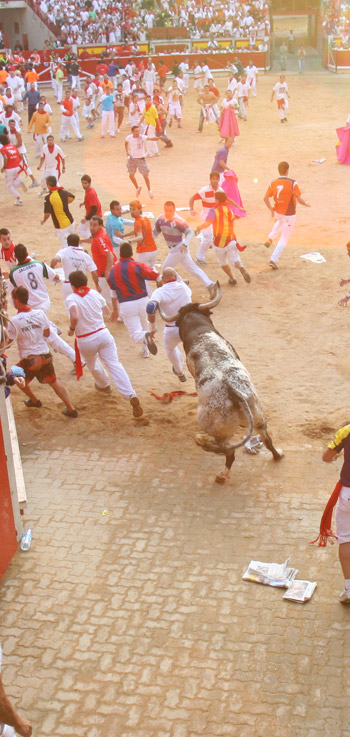
The Bull Runner’s Runner – A chat with Julen Madina
There was no particular order to the questions I asked him, so this is how it went from the first question to the last. There was, however, one question I had to ask, and it’s become what I call a “Bay of Biscay” question…that is, I was glad that the Bay of Biscay lay between us when I asked it. Not to mention the English Channel, a whole load of hills and mountains and a thousand miles, too…Anyway, that question comes up fairly soonish, so until then… The first thing I asked came up after something Rex Freriks had said a couple of months ago, about how he’d be in his position on Estafeta and as the bells chimed and the rocket went, he’d look across the way a bit and see Larry Mazlack, and they’d both give each other the thumbs up, and that got me wondering if Madina had a particular pre-run ritual. Many do, of course…my pre-run ritual was staying out all night and then heading to the run at about 7.30, if I’d managed to stay awake, for the world’s quickest sobering up medicine…the fear and adrenaline of waiting for the encierro. But here’s how Madina did it:
“Si, si, I always did the same. I got up at six thirty and I’d feel quite stiff, so I’d stretch and warm up a little, and have a light protein drink and pray to my saints. I’d pray to San Fermin, who I had on the table, and pop into the bathroom. Very important that! Around about 7.15 I’d leave for Pamplona and get there about 7.35 or 7.40, and get into my warm up zone. I’d warm up really well, so I’d be ready to run and be not just mentally prepared but physically too, and at about 5 to 8 I’d go downstairs and out into the Estafeta and get to my place, and…”
I’m tingling already. It’s a long time since I ran, 13 years now, but I have never forgotten that pre-run feeling, and the electrically charged buzz that seemed to come through the very cobbles (in those days) of the street and gently course upwards through my feet and legs until my whole body was warmed up despite the chill of the morning…oh god, how I miss it.
As some of you may know, Madina retired in 2010, but I wanted to ask him if there wasn’t a small part of him that was happy that he didn’t have to run any more…
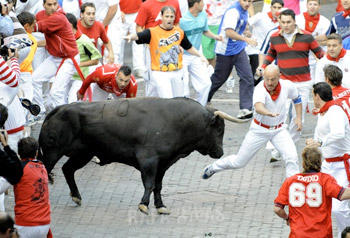
“No, the complete opposite. Something inside of me has gone out, resulting in it being very difficult for me to be in Pamplona but not run in the Encierro. There is always a part of me that will want to run. Let’s see if this year I can find one way or another to be bound, or involved in the run so I’m able to be in Pamplona”.
I’m pretty sure by this he means hoping to be involved somehow in commentating on the run for the radio or television, and I wish him the best of luck in that.
In 2004 Madina suffered a terrible goring in the tunnel into the bullring, the video of which you can see in April’s posting, “Retarded Runners”, (and I’m still not sure about that title), but I wanted to ask him about afterwards…did he recover perfectly from his injuries to be able to run as before?
“Well, I can say yes, I recovered fine. It took a lot out of me to recuperate, because it’s one thing to recover from the wounds, to improve your mobility, all this is good to have a “normal” life, but to remain competitive, well, that’s another thing. I needed my legs to respond properly to be able to run, and that was hard. Mentally, I was fine, but physically it had affected me, and although I was okay, I was slower”.
Okay, now it was time for the Bay of Biscay question, and I can tell you I was glad there was a big stretch of water separating us. A very big stretch…Now I already knew the answer to this, but I had to ask it, as it’s been doing the rounds ever since I first went, and was probably around before that too. But even as an inexperienced runner I knew it was rubbish, but some people just can’t lay off telling lies or repeating rubbish, as they were born to bullshit, so here’s his answer to my Bay of Biscay question. Oh, and it doesn’t really need any translation, I think any of you would get the drift of his answer, and the force of it, but I’ll do it in English anyway. With a bit of his Spanish left in… I’ve mixed and joined his spoken and written answers here.
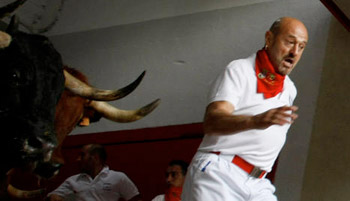
Tim: Julen, I have to ask this, even though I know the answer: Is it true that when you ran, you used other running friends as “blockers”, so you could have a good run?
Julen: These stories are just such immense, enormous stupidity. Really, tremendous rubbish. (Chorrada, gilipollez, anormalidad, ignorancia, estupidez…en fin)…these comments show an extreme ignorance of what represents an encierro, of how it is, of what happens during it”.
Phew, thank you Bay of Biscay…he didn’t shout down the line or get angry, but the real force of his feelings about these ridiculous lies certainly made themselves felt. We went on to have a little chat about it, the gist being that no matter how good you are, you just cannot organise a group of people to run in a certain way so that you have a clear path to run in. To speak very generally, for those who don’t know, I’m going to state the obvious… the run is fairly unpredictable, some runners are pretty unpredicatable too, and the bulls, well the bulls don’t behave in any way that anyone can really control, once things start to get messy. To put it mildly!
I still hear stories today about “the blockers”, but with some people, you just can’t fight their bullshit. They were born to bullshit, they’re members of the Bullshit Peña , and they are not going to change, sadly. Shame.
As someone who ran from 1984 to 1999, when I first did it I didn’t really have a clue. I’d never seen the route, walked the run, talked to anyone about it or anything. I didn’t know it was closed at certain points to funnel everybody in near the beginning, I didn’t know the authorities slowly opened up the route so the crowds could move forwards and gave a little more room for everyone…I really didn’t know much at all. So that first run of 1984 found me half way down Santo Domingo with the friend I’d travelled down with, thinking to myself, well, this is rather narrow and crowded…I could tell which way the bulls were going to come, obviously, but as I rather nervously had a cigarette and realised that the place was getting ever more crowded, (and I was sure the street was getting narrower, too), I also noticed that there wasn’t really any way of escape, unless you were Spiderman, just high walls on both sides and a downhill run towards the bulls one way, or an uphill run and hopefully freedom the other way. By the time the first of the bells started to mark 8 o’clock, I could swear the street had narrowed to about a yard wide.
Tensión en el callejón.Well, the 8 o’clock chimes sounded, there was a whoosh! as the rocket went up and then a loud bang!! and…my first run. Oh…my…gawd…And I have never, ever, forgotten it. Holy mother of all the saints…
Over the years I ran most parts of the run but soon settled to a place that I just felt comfortable with, and I wondered if Madina had always run the top end of Estafeta. Just like the bulls during the bullfight when they find a spot they feel comfortable in to fight, called the “querencia”, many runners end up finding their own encierro querencia on the route, and stick to it.
“My first two runs (he first went in 1971) were from the Town Hall square, to Mercaderes, until the beginning of the Estafeta. On my 3rd run I positioned myself about 40 meters up from the Estafeta curve, as the herd were pretty defined in position having taken the curve, and from there I would try to make the bull ring, (they were different times then!), and you could make it, but over the years I moved up Estafeta, to the last section practically opposite Bar Fitero, and from there I’d run into the ring”.
On another thread, I’d always wanted to run in some of the other towns I heard about in my first couple of years there, but never did, but for those of you who want to, or have, here are some of the other places he has run and what he thinks about them.
Tim: What other runs did you do? (And I love his description of the Falces run).
Madina: “I’ve run for many years in Tafalla, they were great encierros amongst friends. San Sebastian de Los Reyes, a fast and dangerous run and very powerful. Falces (for those who don’t know it’s on a hillside), is like a mad dash downhill escaping from a herd of mad cows. Cuellar, a playful encierro and very beautiful. Tudela I actually think is one of the great ones. Ampuero is curiously lovely, and is run at a decent time of the day. And Deba, the only bull run in Guipuzkoa”.
He went on to add: “I don’t understand those who say they love to run but then only ever run in Pamplona, because if they love the bulls there are many good encierros around”.
Tim: Do you think you’ll ever run again? What do you do now to take its place?
Madina: “Some decisions have to be taken at certain times, and I think I made mine (retiring from running) at the most apt time. If I did run again it would be in Tudela. I’ve been trying a few other things to keep the adrenalin going, adventure sports and such like”. For those who don’t know, Julen gave up running due to the birth of his daughter. It has obviously been an incredibly hard decision for him for sure, but made for absolutely the right reason.
Now here’s a question for everyone who has done a fair number of runs: what was your best run, or your favourite one? For me that’s easy, as there weren’t too many good ones, but for someone like Madina, who ran for 40 years, and is widely acknowledged as one of the great runners of all time, well…would he have an answer to that one?
Oh yes…
“It was July 8th, 1981, with Aguirres bulls, running 200 meters with the 6 bulls, and also at the final section I was with Joe Distler, Atanasio, my brother Pepelu, Miguel Eguiluz and others I don’t remember, all good runners, and all, and this is important, dressed in whites…it was quite evidently a different era. Along with being great runners, there was much more respect in those days, something that now has disappeared”.
I love hearing peoples old stories about fiesta, whether about the running or the partying, and obviously someone who has such a history as Madina does has a few tales to tell. Here are just a couple more.
“I began running in 1971, and I never missed a year. In 1978 I was doing military service in Madrid, (it was obligatory in Spain until the late 1990’s), and as July arrived I asked permission if I could go and run with the bulls. Naturally my captain told me no, but as I was giving personal sport and fitness training lessons to the bigwigs, I told them that if they didn’t give me permission to go then morally I felt I couldn’t continue to train them. And so the Commandant forced the captain to allow me to go and hence I made it to Pamplona.
But I only arrived at midday on the 8th, so I didn’t run that day, but I did go to the bullfight and so experienced the arrival of the police into the ring, (it was the year of the riots mentioned in last months piece that caused the suspension of the entire fiesta), and lived the general chaos that enveloped the place, the rubber bullets, the tear gas, and the confrontations with the police. I was drunk and went to punch a policeman, but my brother Xabier grabbed me and got me out of there…
There was rioting in the streets, and the death of German. (German Rodriguez, the young man shot by the authorities, again mentioned last month and a whole story on its own). It was a dark episode, everything was still too close to Franco’s military dictatorship, and though he had died on 20-11-75 the system still wasn’t ready for certain things”.
Well, that’s about it. A couple of things that shone through our chat were his love and passion for the run, of course, but also his absolute respect for the run and its traditions. And as for certain runners, when I asked him if he had anything else to say, well, he was worried about giving names in case he forgot anyone, but he had already mentioned some during our chat and so, at the risk of leaving anyone out, he wrote this:
“I can only give thanks for all those moments that I have lived and for the great friends that I have, and there are too many people to be able to mention everybody…but some, yes I can name them. Firstly I always remember someone I consider a visionary, literally a maestro, who took on and became thanks to his charisma, a part of a group of youngsters running the encierros of La Ribera around Lerin, and it’s he who most influenced my style of running and of understanding the encierro…Tito Murillo. Another great is Atanasio…and there are few who are in love with the encierro and respect it and run like Joe Distler. Another top man is Miguel Eguiluz, and of course my colleague, Jokin (Zuasti)”.
And then, like the man he is, he ended with, “I don’t want to name people, for fear of forgetting someone”. That’s my favourite kind of runner…thinking about others. It shows such respect. This after all is the man who, having run into the ring with the bulls, would then run back out again to pick up any stragglers…and goodness knows how many people he saved in his time by attracting the bull from runners who were in serious trouble. He has described one of his friends, who is also one of Los Diviños, (and that lot are a whole story in themselves too), as a “maestro”. Well, I think that I can truthfully say then, with the safety of the Bay of Biscay dividing us, that Julen Madina was a maestro too. A Bull Runner’s Runner.
That seems as good a place as any to leave it, for now. So muchas gracias Maestro, for your time and patience in chatting to me and then following it up thanks to my multi-tasking incompetence, with the written word. Eskerrik asko.
Oh and that smell? That essence of primeval times past? A bottle of Patxaran to my favourite description, if any of you can…all I can think of is that the bulls, certainly when you’re under them, smell of hot, dried, earthy curried dung.
MEDIEVAL – The Gateways of Old Iruña.
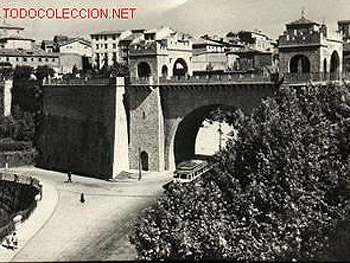
I was going to write this little bit for the July piece, as that’s when most of us will be heading off to Spain and it just seemed like the right time…but it’s June already and I’m too excited so I’m going to include it in this months bull runnings. I use the term gateway above, but I just mean any of the old ways into Pamplona , be it under one of the arches or over one of the bridges, or along a dusty track…Although I think the word “portal” does make it sound like the entrance into another world…which it is.
Ever since I first went to Pamplona there comes a point near the very end of the journey that I think…yes!…I’m here, this is it, finally… Pamplona ! And that bit is when whatever car I’m driving passes under the Portal Nuevo. For it’s then that I know that I have arrived, and left the motorway and the outer suburbs behind and entered my beloved Iruña.
Once I’ve driven up the hill that Pamplona was built on, (remember, the city is about 1450 feet above sea level), and passed under the Portal Nuevo, I’ll see on my right the Taconera Park and then the Hotel Tres Reyes, and on my left the old village or burgo (independent borough) of San Cernin and the church where the statue of San Fermin is kept, La Iglesia de San Lorenzo.
And I know I have arrived. Passing under that archway always gives me a buzz, whatever time of year it is I’m visiting, but especially so when it’s fiesta time. The original city is off to my left inside what is now known as the Casco Viejo, the old town, which was originally just a tiny village (we are going back a thousand years here), called Irunea, or Navarreria, which is the street where the La Mejillonera, the Mussel Bar is, and leads up to the Cathedral.
Then another village was started around 1090 – 1100, the aforementioned Burgo de San Cernin, and finally the around the same time but separated by a moat, the Poblacion de San Nicolas. It’s fascinating stuff, as all 3 districts fought each other until merging to become Pamplona , but that is also a story for another day.
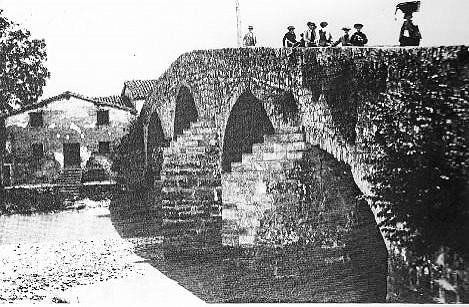
I wanted to mention the gateway because there are four of these constructions that mean a lot to me in Pamplona , as they all signify something special for me. Another one is the Puente de San Pedro, and this one is a cute little stone bridge dating from almost certainly Roman times, and I first saw it in 1984 with the crowd I’d been hanging out with in the gutter. We’d heard that there was a public open air swimming pool, with showers and a bar…and we found it, and there it was…a fiesta oasis for those of us living in the streets. Seeing that little bridge meant a shower and food and rest, sorely needed after a night out on the grass in the square where we lived or the cobbles of the Estafeta and the beer shops.
Even when we found accommodation of sorts, (a floor in an accounting school on the Estafeta), we still headed towards that bridge and went to the pool…seeing that bridge became like a crossing to a parallel world…but a sane one. Years later we had a flat in one of the suburbs, Rochapea, and that pretty little crossing meant one of two things, depending on which way we were going: bed…or party!
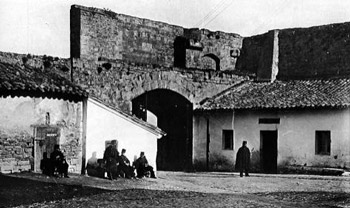
Just up from it, as we walked into town, was the real portal into another world, a crazy, insane, parallel world of fiesta, and that was the Portal de Francia, or Zumalacarregui.
Again though, depending on which way you were going, it had two different meanings. As it was the gateway right at the edge of the old town, it meant either sleep and siesta…or fiesta and insanity. Oh happy daze…
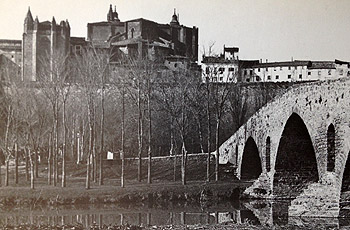
Finally there is El Puente de La Magdalena, and I love this one because from it you can see one of my favourite spots in all the world, and from that favourite spot I can see the bridge, and wonder what it must have been like centuries ago approaching the town over these bridges or entering through those gateways.
Ah well, not long to go at all now before the madness begins again and we can enter through whatever portal the parallel world that is Pamplona in fiesta. I’ll leave you with something that one Bernie Neumatico found a while ago, and though it’s not Pamplona …it may just put a smile on your face and get you in the mood.
Ya falta mucho menos. Viva San Fermin!

